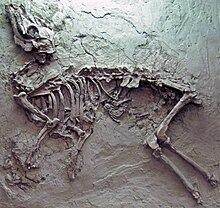| Pseudoprotoceras Temporal range: Late Eocene PreꞒ Ꞓ O S D C P T J K Pg N ↓ | |
|---|---|

| |
| Skeleton | |
| Scientific classification | |
| Domain: | Eukaryota |
| Kingdom: | Animalia |
| Phylum: | Chordata |
| Class: | Mammalia |
| Order: | Artiodactyla |
| Family: | †Protoceratidae |
| Genus: | †Pseudoprotoceras Cook 1934 |
| Type species | |
| †Pseudoprotoceras longinaris | |
| Species | |
| |
Pseudoprotoceras is an extinct genus of Artiodactyla, of the family Protoceratidae, endemic to central North America. It lived during the Late Eocene 37.2—33.9 Ma, existing for approximately 3 million years. Pseudoprotoceras resembled hornless deer, but were more closely related to camelids.
Body mass was similar to other Eocene protoceratids such as Heteromeryx and Poabromylus yet greater than Leptotragulus and Leptoreodon. Miocene members were apparently larger as well.
References
- Pseudoprotoceras at fossilworks
- Emry, R. J., and J. E. Storer. 1981. The hornless protoceratid Pseudoprotoceras (Tylopoda: Artiodactyla) in the early Oligocene of Saskatchewan and Wyoming. Journal of Vertebrate Paleontology 1:101-110
- McKenna, Malcolm C., and Bell, Susan K. 1997. Classification of Mammals Above the Species Level. Columbia University Press, New York, 631 pp. ISBN 0-231-11013-8
| Taxon identifiers | |
|---|---|
| Pseudoprotoceras | |
 | This prehistoric even-toed ungulate-related article is a stub. You can help Misplaced Pages by expanding it. |